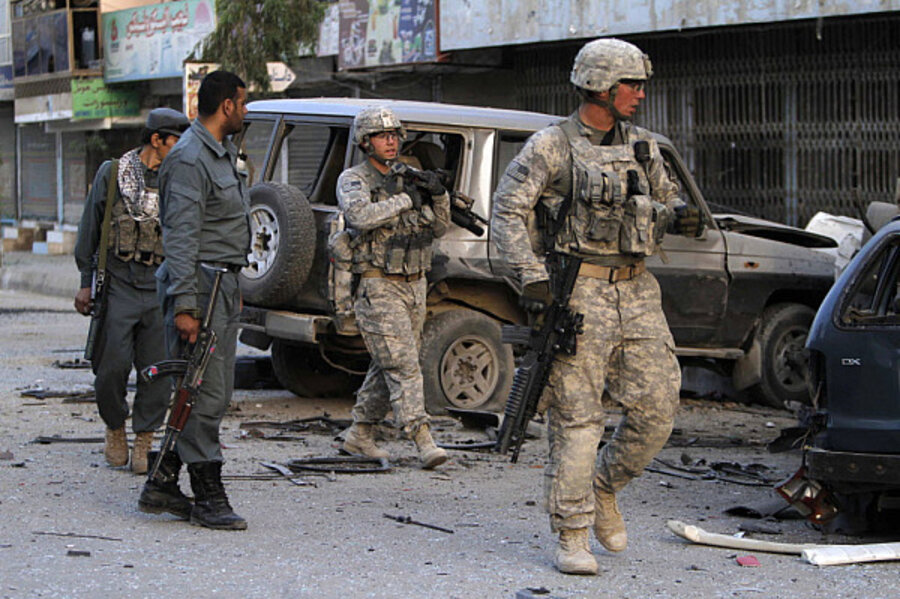Afghanistan war: surge on cusp of bringing 'real change'
Loading...
| Washington
Insurgents in Afghanistan think last year was their most successful year of operations since 2002, according to a new Pentagon report.
That perception stems from a plentiful supply of weapons, including roadside bombs, and money, and also from the narrative in Washington for the last several years that the US was losing the Afghanistan war.
But armed with the confidence that comes from a surge of 100,000 American forces, US officials now believe they are on the cusp of change, and that insurgent perceptions of their own strength will begin to change, too.
“We have the beginnings for the potential for real change,” says a senior defense official, who spoke on background to reporters at the Pentagon.
The defense official spoke as the Pentagon released a progress report on Afghanistan that the defense official characterized as a “serious and sober” illustration of the challenges the US faces there.
Six months ago, the Pentagon issued a similar report that showed that security was stable, not declining, but “fragile.” Today it appears as if the military is still in wait-and-see mode. The trends are mixed.
Insurgents losing popular support
For example, insurgent groups are losing favor among the Afghan people, says the report. And according to a poll taken last month, 52 percent of Afghans believe insurgents are the greatest source of insecurity. On the other hand, only about 24 percent of the population supports the government of Afghanistan in 121 of the districts that are critical to turning the country.
“The establishment of effective governance is a critical enabler for improving development and security,” the report says.
Meanwhile, the number of attacks against coalition forces is up, too.
For example, since President Obama announced the surge in December, insurgents have staged hundreds more roadside bomb attacks over last year. In the southern region, for example, where the violence is the highest, there were roughly 550 roadside bombs – bombs that exploded or devices that were found and cleared with detonating – in October 2009. Last month, there were nearly 800. Overall, the number of roadside bombs or bomb discoveries increased 236 percent over last year. There were a total of 4,617 incidents between October 2009 and March 2010.
“The overall Afghan insurgent strategy going into 2010 is to counter ISAF [International Security Assistance Force] expansion and cause casualties to international partner forces with the expanded use of [roadside bombs] and suicide bombings, while undermining efforts by the Afghan government to improve governance and increase influence around the urban centers of Kandahar and Kabul,” according to the report.
The report on Afghanistan, mandated by Congress every six months, shows that the insurgency can boast a number of strengths. These range from the speed of its “information operations” – exploiting attacks against coalition forces to convince the population that the US is losing, for example – to the insurgents’ ability to intimidate that population through “targeted killings and threats.”
Increasingly sophisticated attacks
The report also noted that “insurgents’ tactics, techniques and procedures for conducting complex attacks are increasing in sophistication and strategic effect.”
But the trends will favor the US and NATO in coming months as the number of American troops Mr. Obama ordered to Afghanistan arrive there and more of the population centers can be protected, defense officials say. At the same time, the strength of the Afghan national security forces, including the army and police, will improve over time.
Insurgent groups are so decentralized, and command-and-control sometimes so difficult, that they are often less effective than they can be, according to the report. And, few groups are on the same page: “Persistent fissures among insurgent leadership persist at the local levels,” the report says.
Pakistani officials have made a series of high-profile, recent arrests of top Taliban and other insurgent leaders in Pakistan. That has triggered “concerned chatter” among intelligence sources about the future of the insurgency. But it has as not yet translated to an insurgency that is significantly degraded, the defense official said.
Related:





